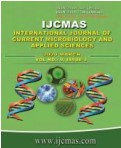


 National Academy of Agricultural Sciences (NAAS)
National Academy of Agricultural Sciences (NAAS)

|
PRINT ISSN : 2319-7692
Online ISSN : 2319-7706 Issues : 12 per year Publisher : Excellent Publishers Email : editorijcmas@gmail.com / submit@ijcmas.com Editor-in-chief: Dr.M.Prakash Index Copernicus ICV 2018: 95.39 NAAS RATING 2020: 5.38 |
In order to assess genetic divergence among thirty genotypes of brinjal, Mahalanobis D2 statistics was applied. The analysis of variance revealed significant differences among the genotypes for all the traits. Based on divergence analysis thirty genotypes were grouped into 10 clusters. Cluster II was the largest having nine genotypes followed by cluster III (8) and cluster I (6). Clusters IV, V, VI, VII, VIII, IX and X are solitary with one genotype each. Among the ten clusters, cluster III with eight genotypes showed maximum intracluster distance followed by cluster II and cluster I. Based on inter-cluster distances, maximum divergence was observed between cluster VII and VIII followed by cluster II and cluster VIII indicating that the genotypes in these clusters could be utilized as parents in hybridization programme to develop high heterotic hybrids and to identify superior transgressive segregants in segregating population. The maximum cluster mean was observed in cluster IV followed by cluster II for fruit yield/plant and fruit yield (t/ha). These clusters could be useful sources of genes for improvement of yield component traits. Fruit diameter(49.43) contributed towards genetic divergence followed by fruits per plant (11.72%).
 |
 |
 |
 |
 |